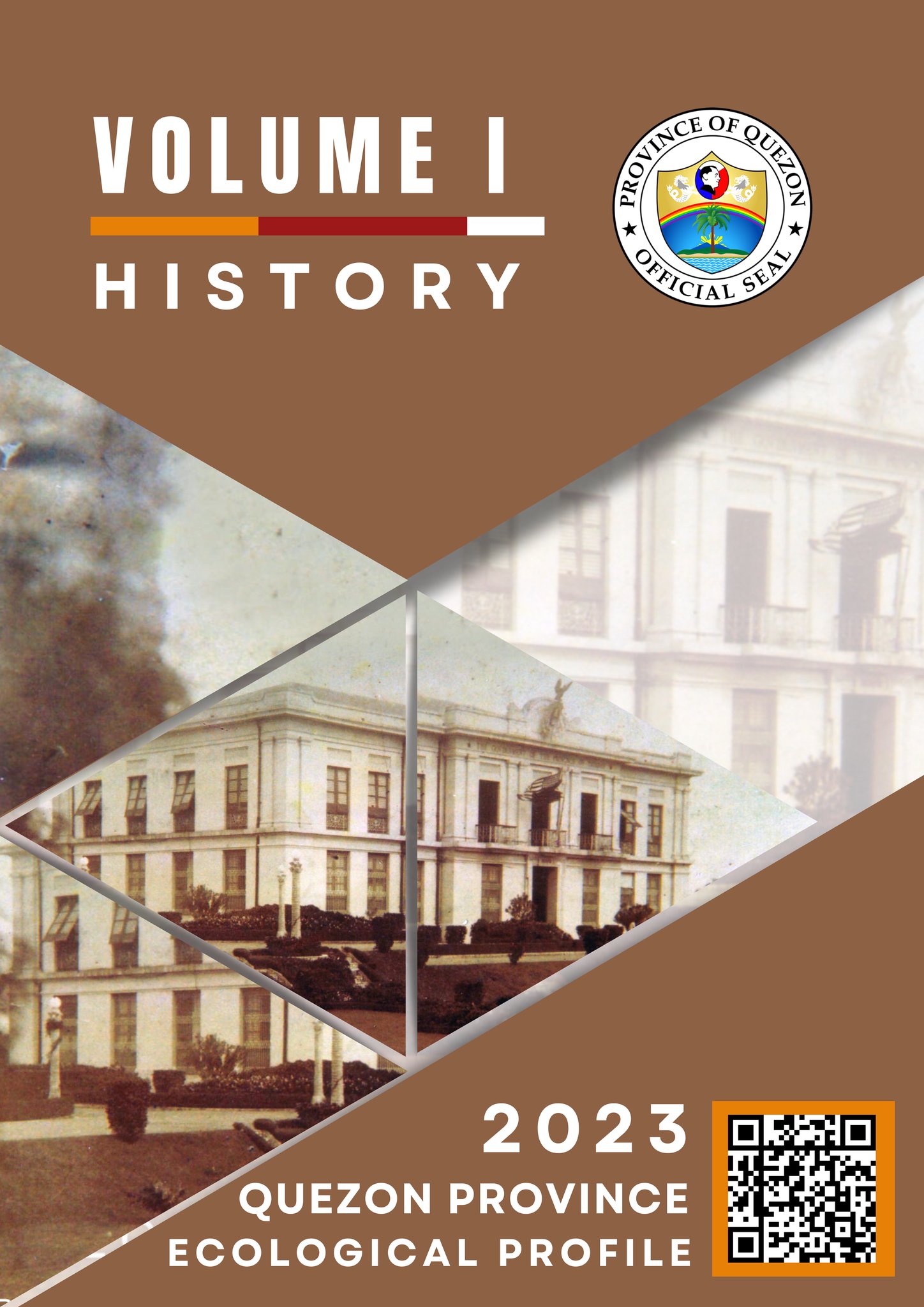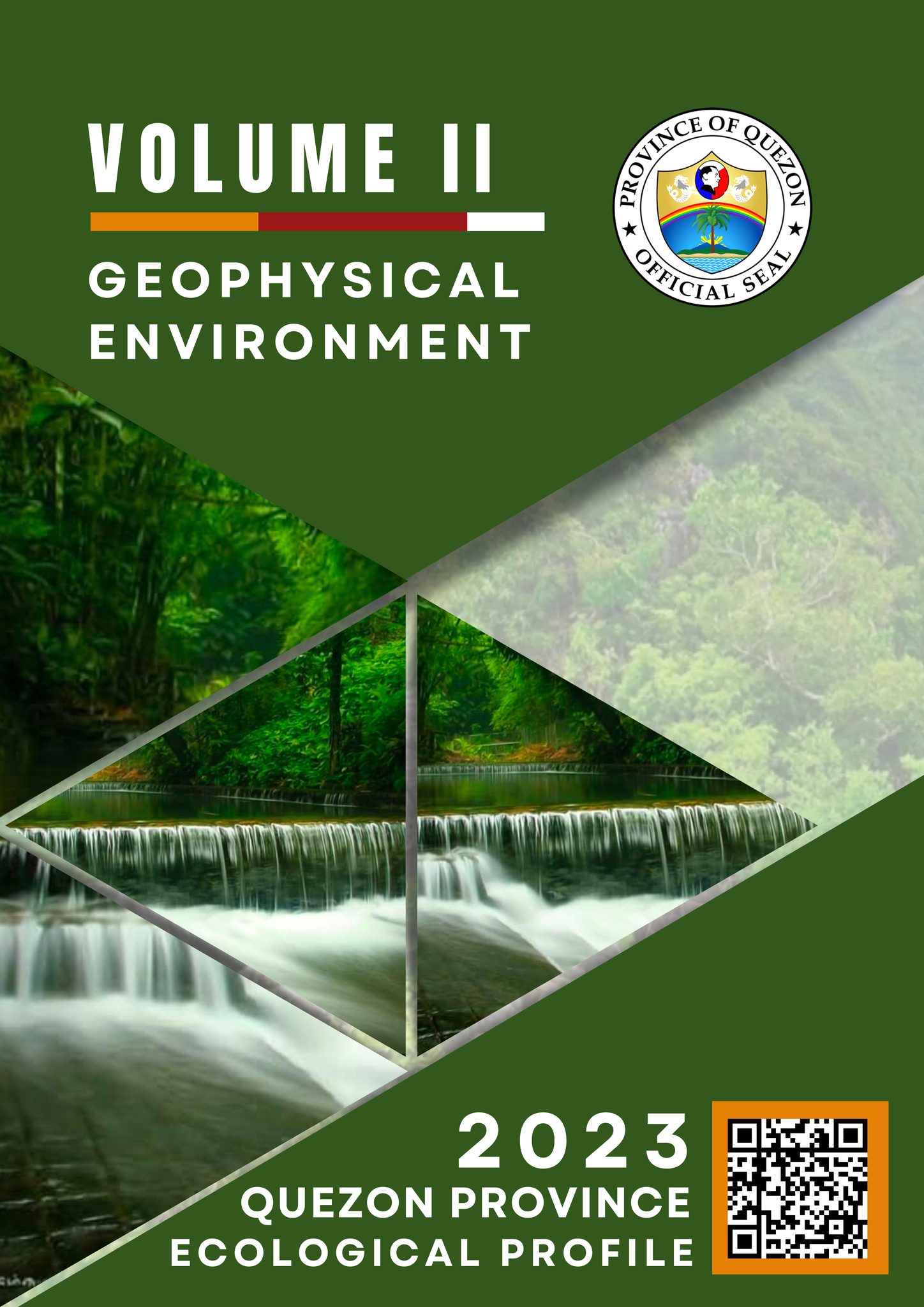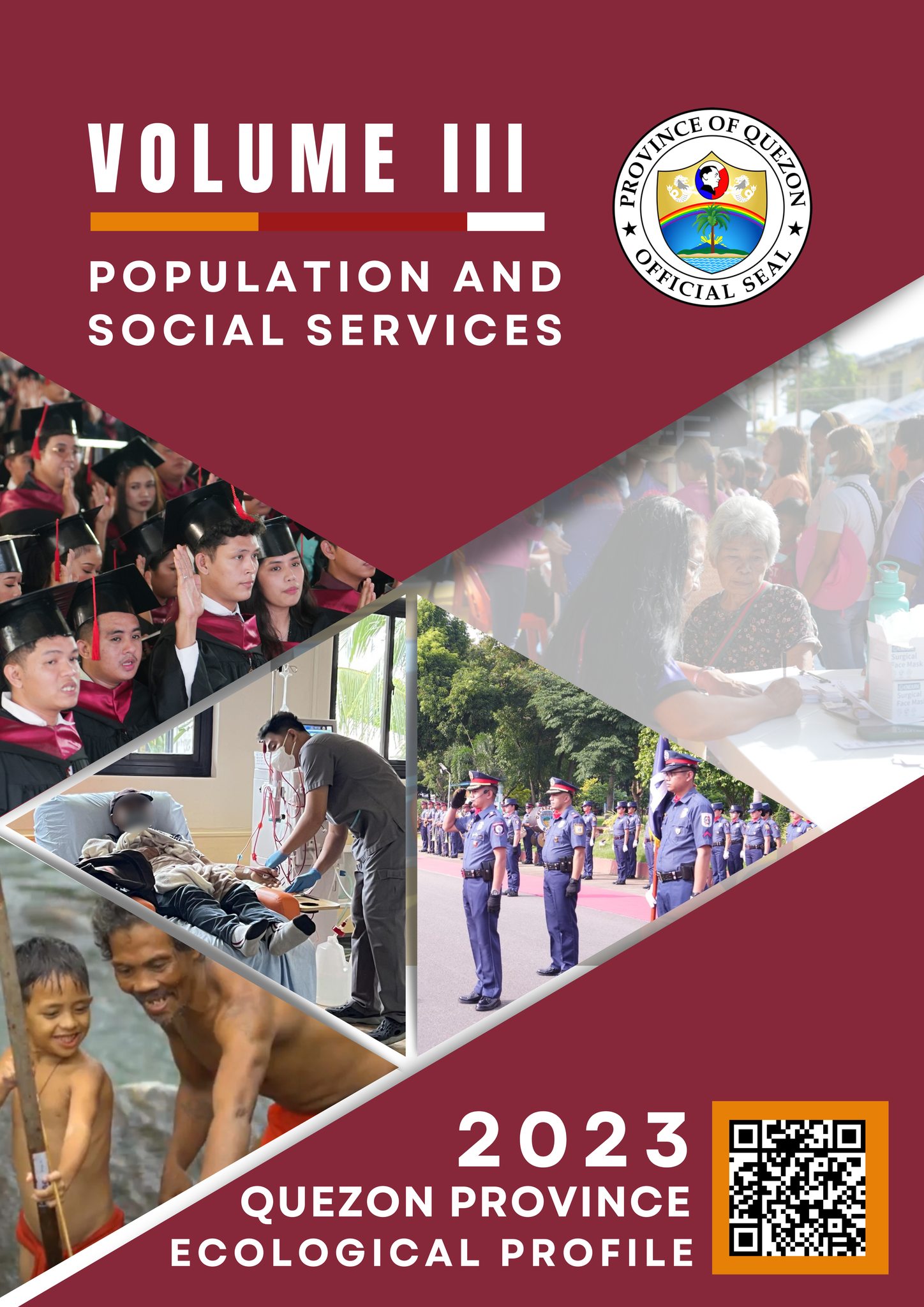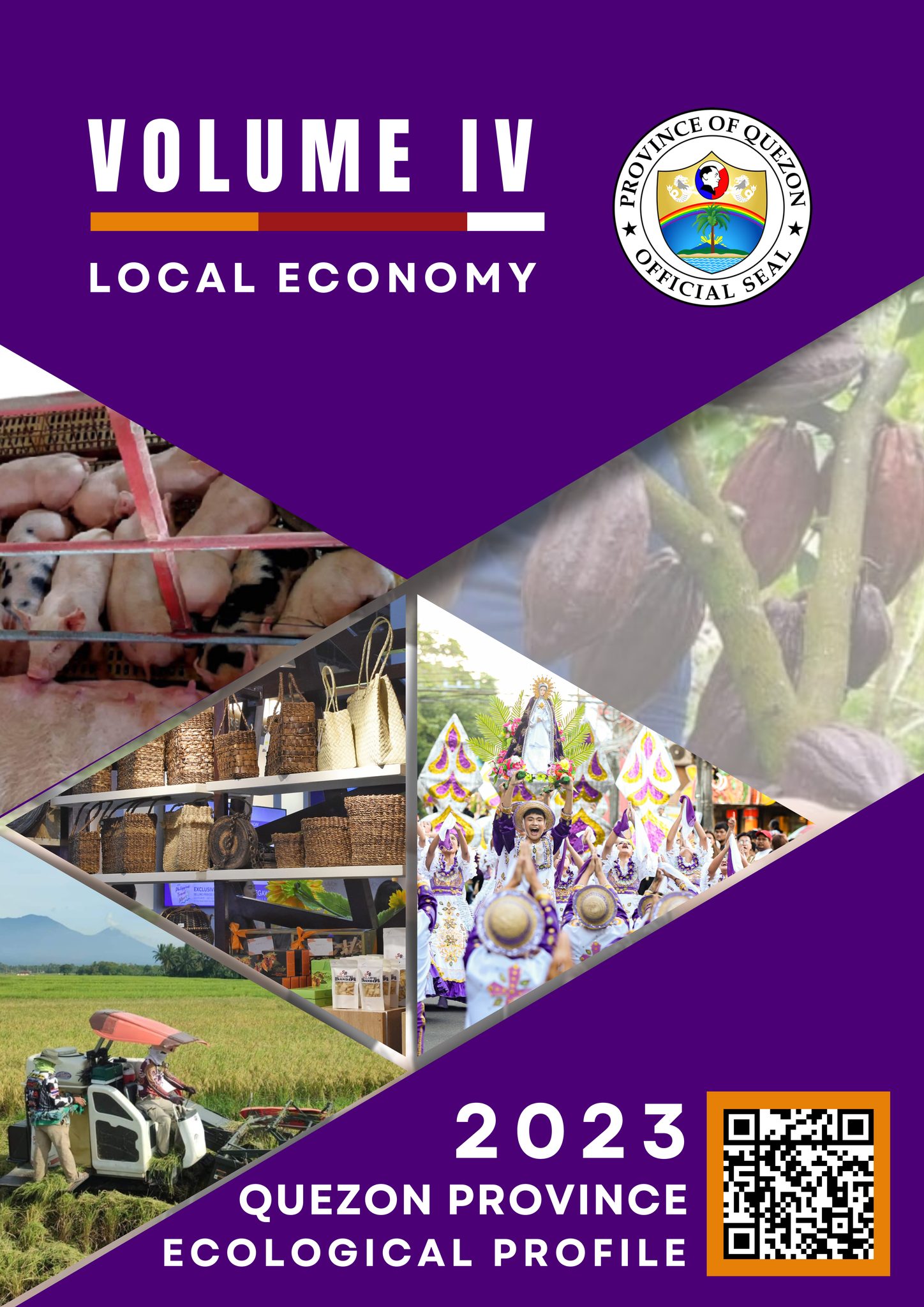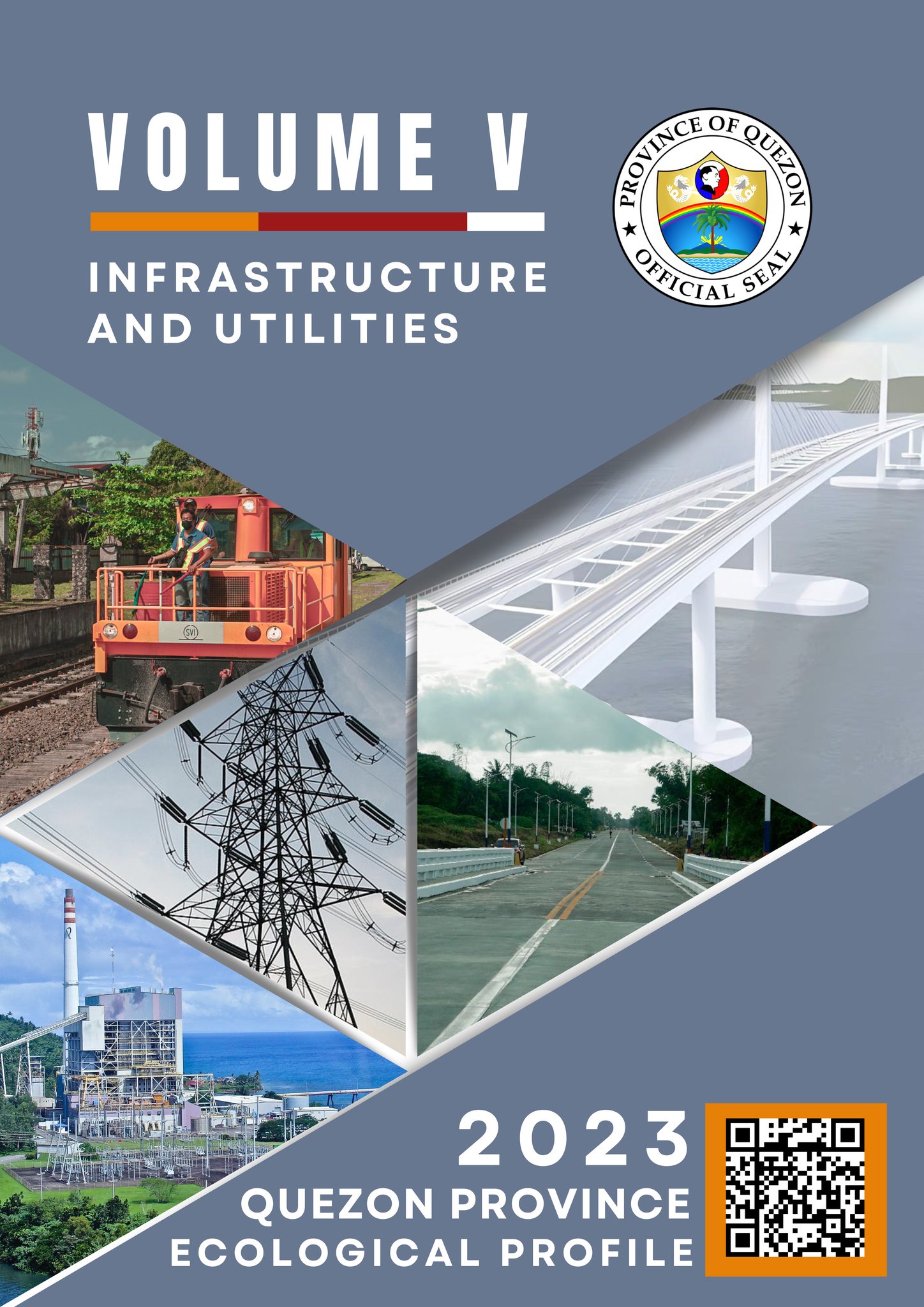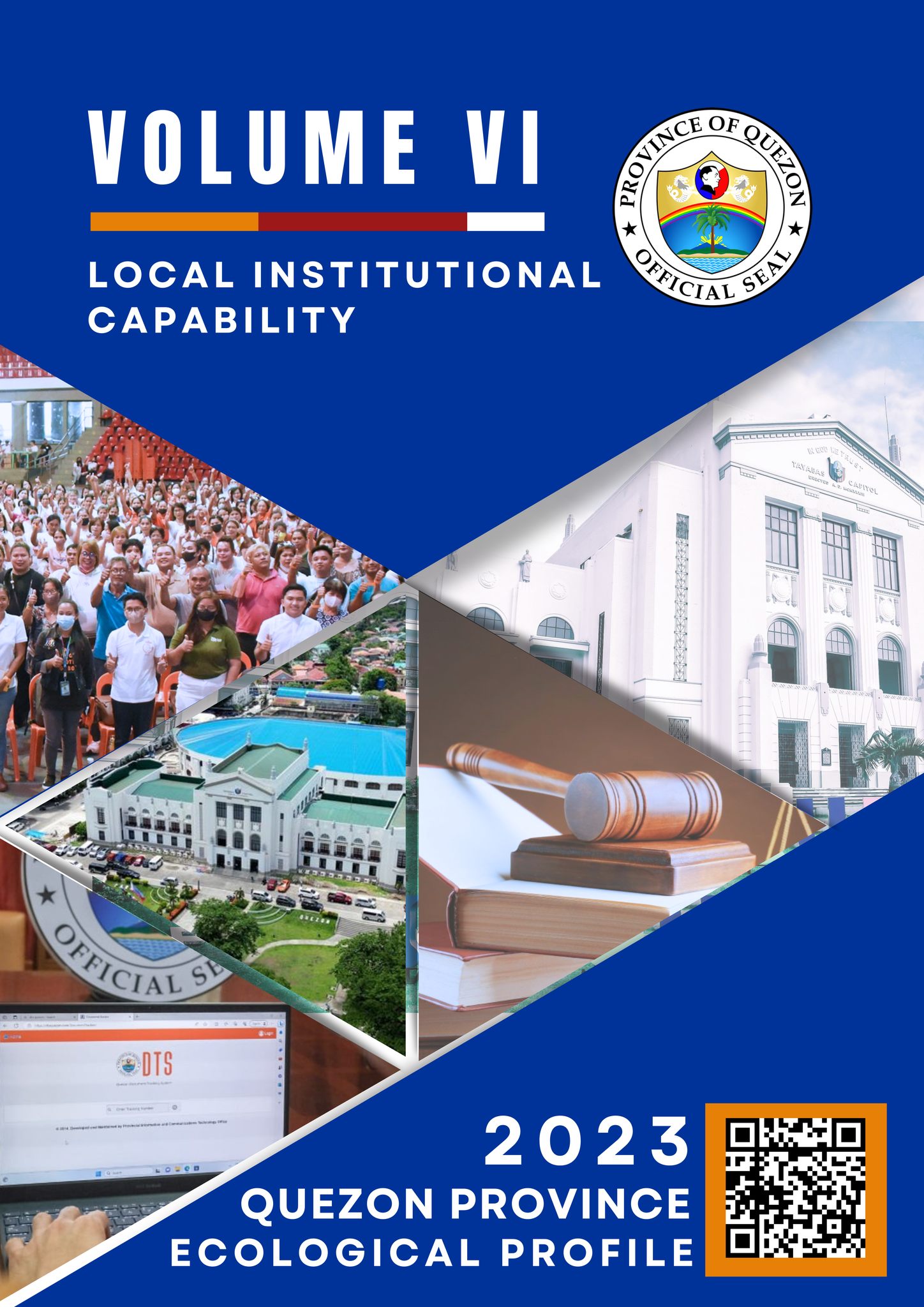Socio Economic Profile
2023 Ecological Profile of Quezon Province
The 2023 Ecological Profile of Quezon Province is a vital document of the Provincial Government which contains multisectoral statistics and information. It serves as a valuable input and reference in development planning activities, as well as for researchers and other relevant stakeholders. It has six volumes which may be accessed through the QR codes in each image, or through the links below:
Socio Economic
BRIEF PROFILE
Quezon Province is a first-class province located in the CALABARZON Region, occupying Luzon’s central section. It is bounded on the north by the province of Aurora Province, on the west by the provinces of Laguna and Rizal, on the southwest by the province of Batangas and on the southeast by Camarines Norte and Camarines Sur. Tiaong, its first municipality via the Maharlika Highway, is about 89 kilometers from Metro Manila, while Lucena City, the provincial capital, is about 137 kilometers southeast of Metro Manila.
The province is composed of thirty-nine (39) municipalities, one (1) component city, Tayabas, and one (1) highly urbanized city, Lucena. These are further subdivided into 1,242 barangays and are grouped into four (4) congressional districts.
The total land area of Quezon is 870,660 hectares or 8,706.60 square kilometers, representing the largest land area share in the region at 53.21% and the sixth largest in the Philippines at 2.65%.
Population
The population of Quezon Province, as determined by the 2020 Census, was 1,950,459 (excluding Lucena City). This number represented 12.04% of the total population in CALABARZON region, or 1.79% of the entire Philippine population. According to the 2020 Household Population, the age group with the highest household population in Quezon is 10 to 14 years old, with 213,163 household individuals and the age group with the lowest household population is 80 and over, with 17,166 household individuals.
The population density is computed at 223 inhabitants per square kilometer (excluding Lucena City). In 2020, there was a total of 483,703 households in the province, with an average household size of 4.0.
Quezon’s annual population growth rate (APGR) is the lowest in the region at 1.04% from 2015 to 2020 (1.70%, including Lucena City). It is also lower than the national APGR of 1.63%. If the APGR recorded from 2015 to 2020 continues, the population of Quezon will double in sixty-six (66) years.
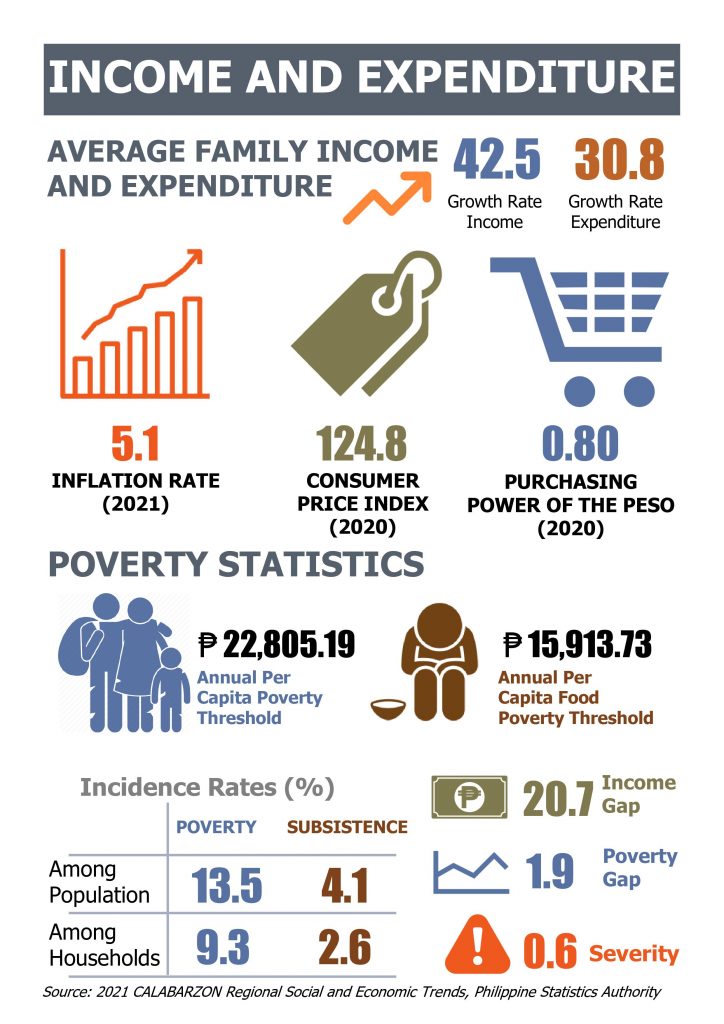
HEALTH
Providing accessible and quality health care services is considered as the top priority of the Provincial Government of Quezon to improve every individual’s overall health condition.
Health Facilities and Personnel
The public health services of the province include government hospitals, municipal health centers, and rural health units strategically located in the entire province.
There are 31private and government hospitals throughout Quezon with 1,647 hospital beds serving the 2,229,383 population in 2020 with a 1:1,354hospital-to-population ratio. Sixteen (16) of these are government hospitals comprised of three (3) municipal hospitals, four (4) medicare hospitals, eight (8) district hospitals and one (1) tertiary hospital, Quezon Medical Center.
There are 41 Rural Health Units (RHUs) distributed province-wide, 8 of which are located in the island municipalities while the remaining 33 are in the mainland and are generally accessible through land transport.
Data from thecities and municipalitiesof Quezon show that in 2021, the government physician to population ratio is 1:17,979, the government nurse to population ratio is 1:3,105, the government midwife to population ratio is 1:4,826, and the government medical technologist to population ratio is 1:4,285.
Nutritional Status
According to the Provincial Nutrition Action Office (PNAO), the majority, or about 106,858 preschool children from 168,976 evaluated in 2021, are categorized as having normal weight. Nevertheless, there is still the need to promote healthy lifestyle amongst households since 9.41% of the preschool children were stunted, 4.27% were severely stunted, 5.05% were underweight, 1.51% were severely underweight, 3.11% were wasted, and 1.29% were severely wasted. These percentages indicate that there are children across the province that are not able to properly eat the daily required food intake. Also, the data showed that about 2.40% and 1.74% of the preschool children were classified as overweight and obese, respectively.
Malaria, Tuberculosis and COVID-19
From 2019 to 2021, there was no recorded malaria incidence in Quezon Province. Nonetheless, preventive measures continue to be implemented to ensure that the province remains malaria-free.In terms of tuberculosis, the DOH reported 10,032 presumptive cases tested with a bacteriological test and a 35% treatment success rate in 2021 (62.7% of cases in 2021 not yet evaluated). 97.56% of LGUs have TB diagnostic and treatment facilities, with a total of 131 facilities in the province. Additionally, in terms of COVID-19 vaccination, sixty-one (61) percent of Quezon’s population and sixty-six (66) percent of senior citizens’ population are fully-vaccinatedas of March 2022.
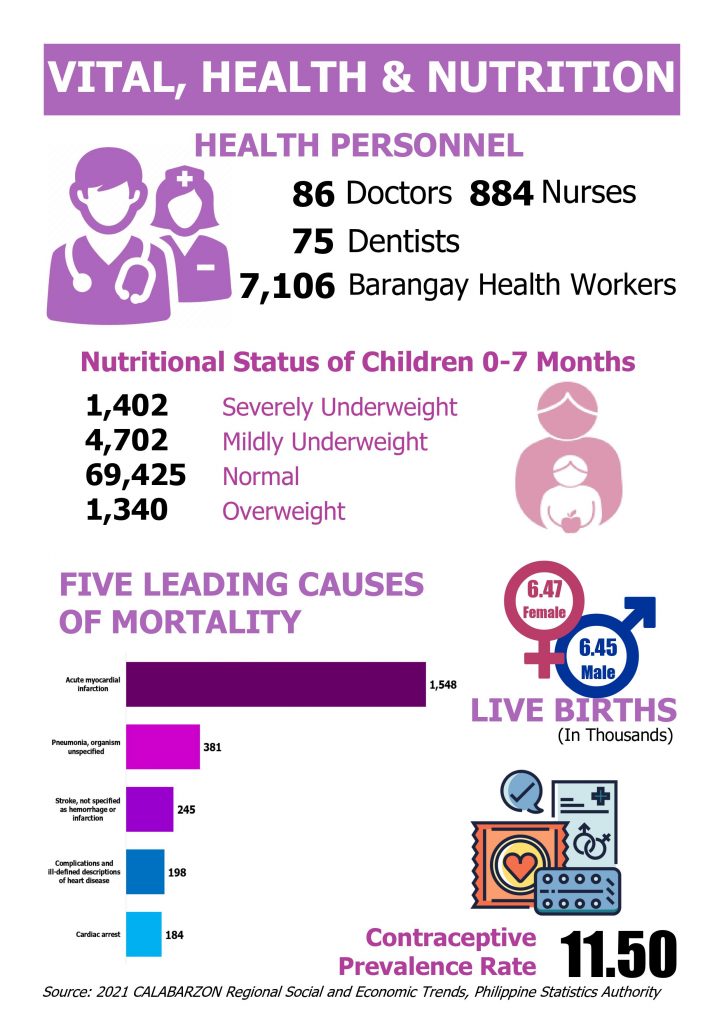
EDUCATION
Quezon Province has 773 elementary schools and 206 secondary schools, 174 of which are offering Senior High School Program.
In the school year 2020-2021, there were 293,800 enrollees for public elementary education in the province, including Lucena City. In the same school year, for public elementary education, the pupil-classroom ratio (PCR) was at 37:1 which is adequate based on the standard pupil to classroom ratio of 45:1. Meanwhile, the teacher-pupil ratio is 30:1 which is better the national standard ratio of 35-39 pupils per teacher. Elementary graduation/promotion rate was 98.19%.
For the school year 2020-2021, there were 176,069 enrollees for public secondary education in Quezon Province, including Lucena City. The student-teacher ratio was 23:1, and the overall student-classroom ratio was 32:1. Secondary graduation/promotion rate was 96.65%.
The province has a total of 49 public and private higher education institutions with 1,920 teaching force. For the school year 2020-2021, there was a total of 45,548 enrollees and 3,245 graduates for the tertiary level in the province.
In addition, Quezon also has a total of seventy-four (74) TESDA-Accredited Training Centers with 328 available TVET courses. In 2021, TESDA recorded 14,689 enrollees and 6,419 graduates. There are nineteen (19) LGUs out of 41, or 46.34 percent, who have TESDA-accredited training centers.
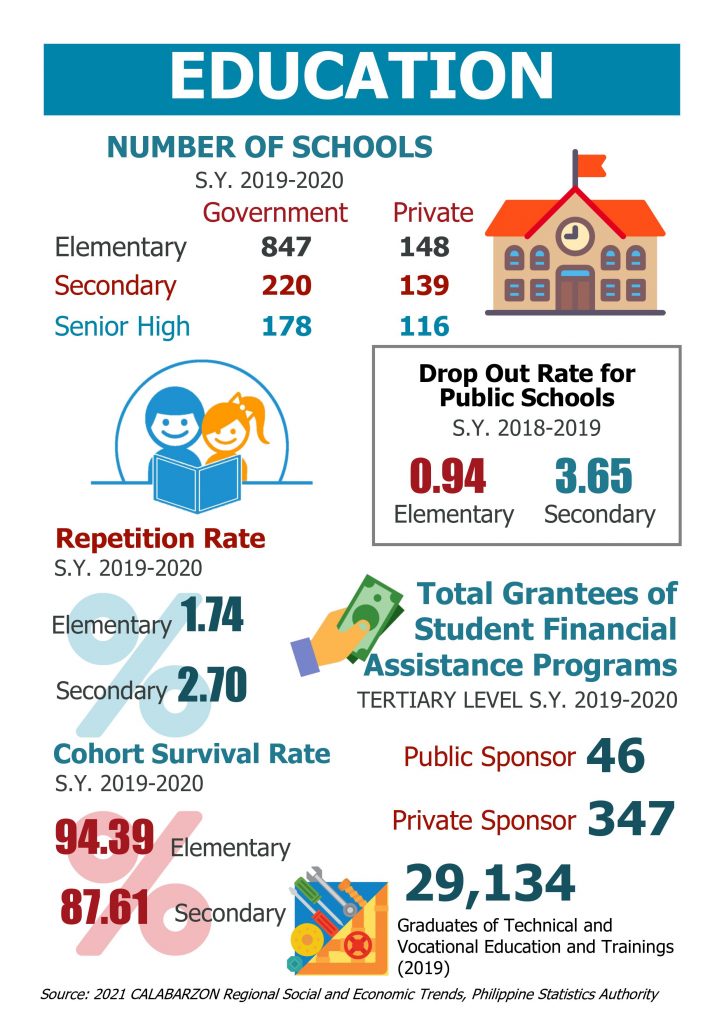
AGRICULTURE
Quezon has a total agricultural area of 4,167.6421 sq. km representing 47.87 percent of the total provincial land area. The total area planted with coconuts covers 379,137.60 hectares, making Quezon the province with the largest coconut production area in the Philippines. Also, Quezon is the top coconut producing province in terms of total coconut production in the country with 1,493,066.64 metric tons in the year 2020.
Copra making is considered one of the largest income-generating agricultural activities in the province. However, with the volatile price of copra both in the local and international markets, the government has encouraged intercropping and multi-storey cropping to generate additional income for the coconut farmers.
Another major crop of the province is rice, covering a total area of 50,183.35 hectares. Rice production is placed at 194,269.99 metric tons with an average yield of 3.87 metric tons per hectare in 2021.
Other crops cultivated in the province include but are not limited to corn, banana, coffee, sweet potato, pineapple, citrus fruits, vegetables and other fruit trees.
Predominant livestock in Quezon are cattle, carabao and swine due to the suitability of the land for grazing animals. Carabao is the most used draft animal in land preparation, as well as for hauling farm products and material inputs for farmers, although power tillers are available in the market. Horses are also utilized for hauling purposes. Cattle are primarily raised for meat production, while there is an emerging industry on dairy production. Swineand poultry production are also emerging industries,including egg production. Backyard raising of livestock and poultry is likewise dominant in many rural areas in the province, both for home consumption and as additional sources of household income.
Fisheries
Quezon Province has abundant marine fishing grounds with the presence of Tayabas Bay, Lamon Bay and Ragay Gulf. Moreover, 34 of its cities and municipalities are along the coastal area, with total coastline length of 1,066.36 kilometers.A diversearray of fish, shellfish, and other economically valuable marine species from these fishing grounds provide a primary source of income for thousands of fisherfolk.
Likewise, inland fisheries abound in major rivers and lakes, as well as fishponds for aquaculture. The most common cultured species in the province for fishpond production are milkfish and prawns. Other freshwater species include white goby, freshwater shrimps, catfish, tilapia, mudfish, and mullet.
Agri-Tourism
Another aspect pursued and promoted by the Provincial Government of Quezon is the development of agri-tourism sites and agricultural enterprises within its borders. These serve as additional source of income for local farmers wanting to further increase their profits as well as provide livelihood to rural women, youth, and other interested agricultural workers. The rural ambience in the province, its hospitable people, and its proximity to the urbanized areas in the region and to Metro Manila provide a ripe opportunity to further develop the province’s agri-tourism potentials. Already popping up all throughout the province are tourism attractions showcasing rural settings such as farm restaurants, organic farms, agricultural learning sites, pick-and-pay harvesting activities, among many others. Agri-tourism is seen to allow the local communities to share and invite people to come, see and experience the agricultural landscape and natural beauty of the province.
LIVELIHOOD
According to the Philippine Statistics Authority Labor Force Survey, the total labor force (those aged 15 years and above) in 2021 is 785,650 or 59.85%. The province’s employment rate, excluding Lucena City, is 93.3%, while the unemployment rate is 6.7%, and the underemployment rate is 17.0%.
The province had a total of 33,773 business establishments registered in 2020, of which, 91.31% or 30,839 are involved in the tertiary sector (service sector), 7.25% or 2,447 are in the secondary sector (industry sector includes economic activities that manufacture finished and tangible products), and 1.44% or 487 are in the primary sector (sector that collects and produces raw materials).These business establishments in the province were able to generate a total declared employment of 150,817 in 2020.
The municipalities identified as potential economic zones as per the Special Economic Zone Act of 1995 (RA 7916) are Infanta, Real, Polillo, Alabat, Atimonan, Tiaong, Pagbilao, Mulanay, Tagkawayan, and General Nakar. Proclamation No. 665, s. 2013 created the Agro-Industrial Economic Zone in Candelaria,while just recently, the Quezon Techno-Industrial Special Economic Zone (QTISEZ) in Mauban was created through Proclamation No. 1277, s. 2022. These are seen to further boost livelihood opportunities and employment generation in the province.
INFRASTRUCTURE
Road Network
As of 2020, Quezon Province has 5,032.360 kilometers of roads of various administrative classifications. Of this, 966.063 kilometers are national roads, 287.840 kilometers are provincial roads, 3,135.305 km are barangay roads, 499.967 km are municipal roads, 41.629 are city roads, and 101.556 are NIA Service or access roads.
Bridges
There is a total of 235 bridges of various surface types and administrative classes in the province. Its total length is 16,069.03 lineal meters. Of this figure, 6,351 lineal meters are national bridges, 911.02 lineal meters are provincial bridges, 4,375.49 lineal meters of municipal bridges and 4,431.52 lineal meters of barangay bridges.
Railway
The Philippine National Railways (PNR) has a rail line traversing the province of Quezon from Tiaong to Tagkawayan. The PNR South Long Haul (SLH) Project primarily aims to provide a consistent six-hour travel time between Manila and Legazpi, passing through 12 municipalities and one city in Quezon Province. It will have new, fast and comfortable passenger trains, while the tracks will also be designed for freight and cargo trains. Currently, the San Pablo-Lucena segment is in operation providing a cheaper travel option for those travelling from Lucena City and San Pablo City as well as Sariaya, Candelaria and Tiaong.
Telecommunications
Telecommunication services in Quezon Province are mainly provided by the Philippine LongDistance Telephone (PLDT), Inc., General Telephone System, Inc.,and mobile telecommunication companies Smart, Globe Telecom, and DitoTelecommunity.Aside from calls and SMS, access to the Internet is also made available by these service providers in the form of mobile data and DSL connection. Nonetheless, there are still far-flung areas which are not yet reached by telecommunications services.
Electric Power Supply
The Province of Quezon hosts nine (9) power plants with a total installed capacity of 2,204.261 megawatts (MW) and a dependable capacity of 2,107.664 MW. Coal power plants account for the highest share of the province’s total installed capacity at 99.6 percent (2,195 MW), followed by oil (0.3 percent or 5.761 MW) and hydro (0.2 percent or 3.5 MW).
Coal power plants in the province include Team Pagbilao Corporation and Pagbilao Energy Corporation in Pagbilao, and Quezon Power Limited (QPL) and San Buenaventura Power Ltd. (SBPL) in Mauban.
In addition, there are three (3) off-grid oil-based plants, two (2) of these plants are operated by the National Power Corporation – Small Power Utilities Group (NPC-SPUG) and are located in Jomalig and Patnanungan.The other oil-based plant is operated by Renesons Energy Polillo, Inc. (REP), a new power provider (NPP) in Polillo.
There is also the grid-connected 3.5 MW LabayatHydropower Plant located in Real, Quezon.
The provision of electricity access at the household level in the entire province is carried out by distribution utilities (DUs), namely Manila Electric Company (MERALCO), Quezon I Electric Cooperative Inc. (QUEZELCO I), and Quezon II Electric Cooperative Inc. (QUEZELCO II).
NATURE AND ENVIRONMENTAL TOURISM
Rugged terrains characterize the province’s topography with few plains, valleys, and swamps. The Sierra Madre Mountain Range runs along the entire length of the area, with Mount Banahaw (an active volcano) rising at 2,169 meters above sea level. Only narrow strips of land along the coast and river valleys are available for growing crops. The undulating lowlands along the coast are well-drained. The province is narrow, averaging about thirty (30) kilometers by width.
396,221 hectares or 45.51% of the total land area of the province are classified as Forest Lands. There are four (4) legislated protected areas in Quezon Province: the Mts. Banahaw-San Cristobal Protected Landscape, the Quezon Protected Landscape (also known as Quezon National Park), the Maulawin Spring Protected Landscape, and the Buenavista Protected Landscape. Additionally, there are fifteen (15) other protected areas as initial components of the E-NIPAS.
Inland water resources are abundant. The most prominent are Umiray, Agos, and Nakar rivers within the Infanta-General Nakar area. Its watersheds are home to rich biodiversity and indigenous communities, as well as providing agricultural irrigation. MalakingIlog in Sariaya, identified as a central river basin by DENR, is also a significant source of water with the most extensive drainage area and highest volume of surface runoff in the province, which generally causes flooding during typhoons and heavy rains.
Quezon Province has a huge potential for optimum utilization of and considerable revenue generation from the tourism sector. There are 180 nature tourism attractions, 104 history and culture tourism attractions, and 42 customs and traditions. Also, there are 41 industrial tourism attractions and 41 sites for sports and recreational activities. Meanwhile, there are alsoseveral venues for shopping activities, health and wellness, and special events.
There are 37 DOT-accredited tourism establishments with total of 1,533 rooms in the province in 2021. There are also numerous locally-registered tourism establishments in Quezon Province such as beach resorts, private pools, tourist inns, etc., which cater to throngs of tourists from both within and outside the province. In 2021, a total of 2,034,485 tourist arrivals were recorded in the province, of which, 2,033,779 tourists were domestic and 706 tourists were foreign.
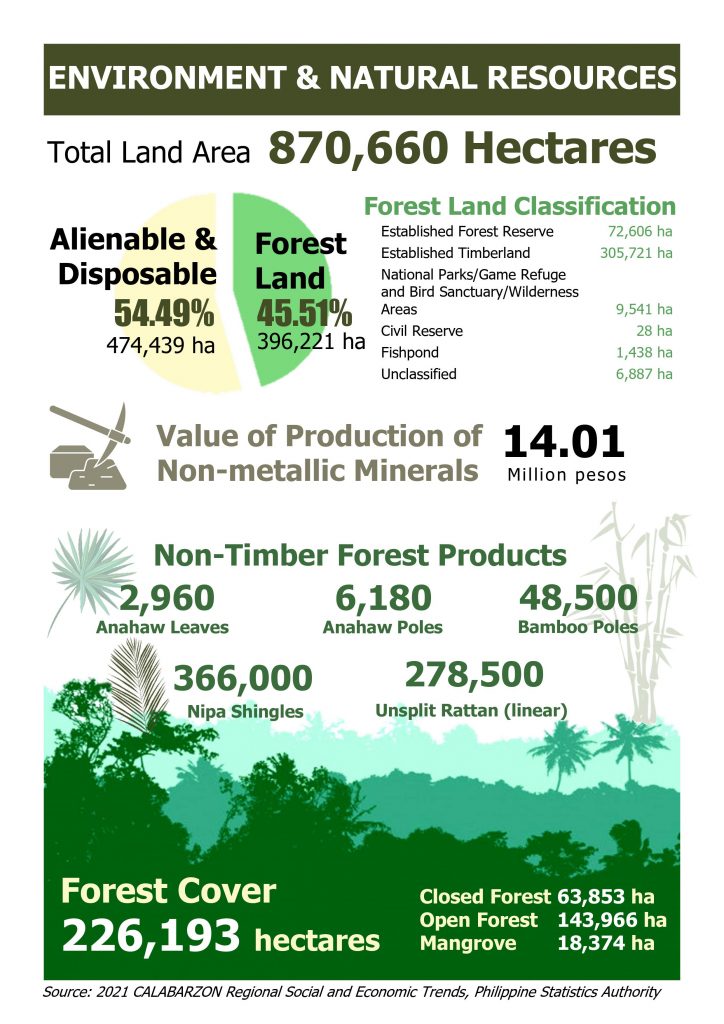
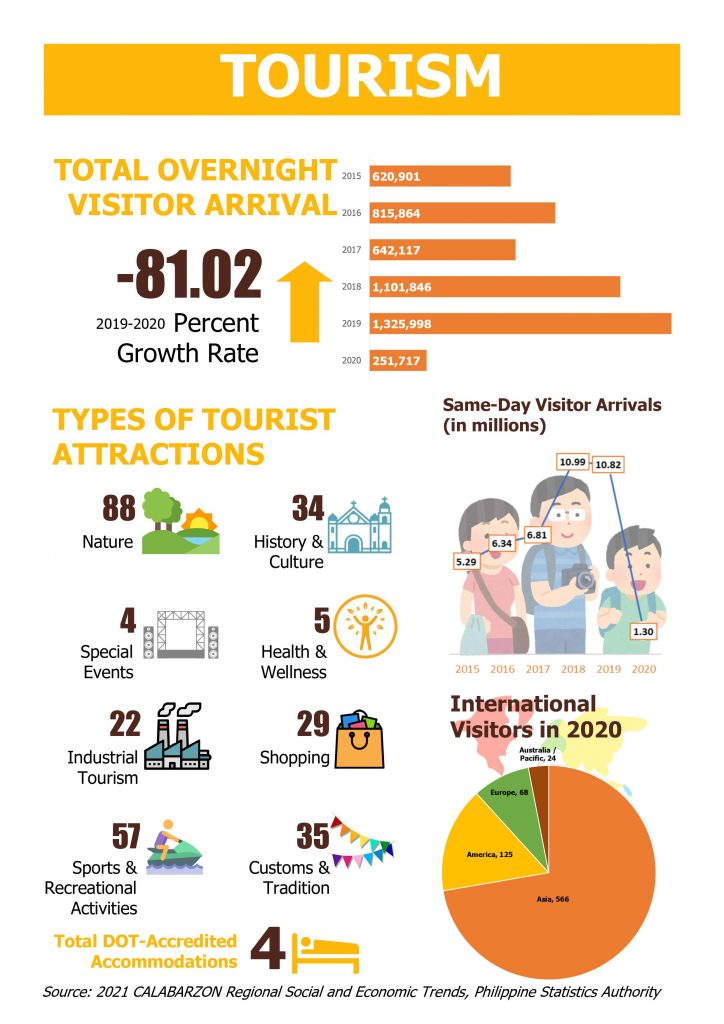
GOOD GOVERNANCE
Local Government Structure
The Executive Branch of the Provincial Government of Quezon is headed by the Provincial Governor. Directly under the Governor are the Executive Assistants, the Provincial Administrator and other attached offices/units. Moreover, there are nineteen separate departments of the Provincial Government of Quezon under the executive branch.
The legislative branch of the Provincial Government of Quezon is the Sangguniang Panlalawigan. The Vice-Governor serves as its presiding officer. There are thirteen (13) board members of the Sangguniang Panlalawigan, with 28 standing committees and three (3) special committees.
The Provincial Government of Quezon has a total of 2,342 employees as of December 2021. Of these, 927 are permanent, 809 are casual, and 606 are job order employees.
Public Finance
Under the Local Government Code of 1991, Local Government Units (LGUs) are mandated to manage their resources efficiently and effectively in delivering services to their constituents. The code also authorizes the LGUs to generate their own revenues and manage their fiscal operations.
The revenue structure indicates that the Provincial Government of Quezon is dependent on the Internal Revenue Allotment (IRA) share from the national income. For the period 2018-2020, the IRA accounted for an average of 76.13% of the total revenues. Quezon Province was recognized as one of the National Top Performing LGUs in Local Revenue Generation in 2021, Top 3 in Year-on-Year Growth on Locally Sourced Revenue, and Top 5 in Highest Nominal Locally Sourced Revenue based on the Bureau of Local Government Finance (BLGF).
Local Legislation
From 2019 to 2021, the Sangguniang Panlalawigan has passed/enacted 2,055 resolutions and ordinances. Majority of which refer to the approval, disapproval and/or return of city/municipal ordinances from the 40 component local government units of the province. This is followed by the annual and supplemental budgets of the component LGUs. The governor is also required to seek the approval of the SP before entering into any contract or memorandum of agreement, hence resolutions on the same rank third among the most numerous passed by the SP.
People’s Participation
The inventory of civil society organizations (CSOs) in the province was able to cover a total of 2,078 organizations as of July 29, 2022. Of these, 542 have been accredited by the Sangguniang Panlalawigan as of September 5, 2022.These organizations are eligible to be selected as CSO representatives to the Local Special Bodies, including the Provincial Development Council, Provincial Peace and Order Council, Provincial School Board, and Provincial Health Board.
Peace and Order
The province also pursues to intensify the campaign against criminality and the convergence efforts of all stakeholders to promote peace and security. In 2021, there is one police officer per 1,082 population. In the same year, there were 7,949 total crime incidents, 796 of which were index crimes, 3,394 were non-index crimes, and 3,759 were vehicular accidents and other quasi offenses. Crime solution rate increased from 78.02% in 2018, to 81.82% in 2019, and 86.22% in 2020. Out of the 1,242 barangays in the province, 743 and 127 barangays have been declared drug-cleared and drug-free, respectively, as of July 2022. Additionally, the ECLIP Info System of the DILG recorded a total of 179 surrendered former rebels in 2021.
Social Services
In 2021, the Provincial Social Welfare and Development Office recorded a total of 179,821 clienteles from various sectors such as women, youth, children, differently-abled persons, and senior citizens. Additionally, the local social welfare and development offices in the cities and municipalities reported a total of 368,437 clienteles served in the same year. There were also 4,267 clients served from the Aid to Individuals in Crisis Situation (AICS) funds of the province and from augmentation by the Department of Social Welfare and Development. There are 1,320 child development centers, 51 senior citizen centers, and 12 crisis intervention centers in the province.

